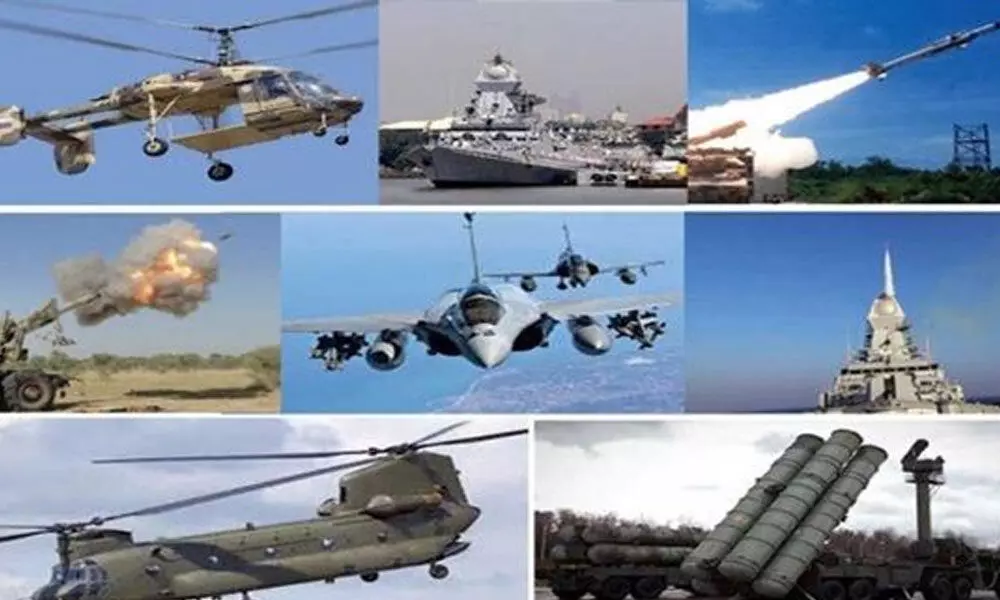Why is India arming itself?
Border tensions with both Pakistan and China are the major drivers for the increased military spending
image for illustrative purpose

The war with China in 1962 and the persistent skirmishes along the borders and wars with Pakistan in 1965, 1971 and 1999 have prompted India to increase its defence preparedness to the maximum.
In 2019, China and India were the second- and third-largest military spenders respectively in the world. China's military expenditure reached $261 billion in 2019, which was 5.1 per cent higher compared to 2018, while India's expenditure grew by 6.8 per cent to $71.1 billion. 'India's tensions and rivalry with both Pakistan and China are among the major drivers for its increased military spending.
The acceleration of skirmishes on the Chinese border is pushing India to position more troops on the border. As a result, India has brought in over 40,000 additional Indian Army troops and equipment to Ladakh. China on the other hand has amassed more than 60,000 troops on India's northern border. China has also been undertaking wide-scale infrastructure development along the 4,057 km Line of Actual Control, which will make the border areas easy to access. China has also provided superior accommodation to house its troops, while Indian soldiers sleep in tents.
The Indian government has now acquired 11,000 extreme cold gear sets from the US army. India last month acquired high-altitude systems for soldiers deployed to forward areas along the Line of Actual Control (LAC) in Ladakh.
"India is now prepared for the winter, except for some small logistics issues here and there." This has debunked China's claims that the Indian Army will not be able to withstand the harsh winter in the absence of required equipment for sub-zero temperature.
But despite all this, the most encouraging part for India is that the Indian soldiers have a huge experience of winter warfare and are psychologically tuned to operate at short notice and face an inexperienced Chinese army.
On the diplomatic front, India, US, Australia and Japan popularly known as the quad group, are collaborating together to work jointly to advance peace, prosperity and security in the Indo-Pacific region. They have begun to develop a set of understandings and policies that can jointly present a true resistance to the threats that the Chinese Communist Party poses to each of these nations.
The quad is also building out a coalition, building partners and allies around the world who understand the threat from the Chinese. There are 16 Asian nations which perceive India to be a threat to Chinese. Therefore, India understands the importance of leveraging defence diplomacy in building mutual trust and partnerships with strategically important countries.
According to top officials of the armed forces, the situation at the LAC in eastern Ladakh remains tense and the possibility of a war with China cannot be ruled out.
Besides having a strong indigenous base for the production of state-of-art weapons and equipment, India will have to collaborate with the big arms exporters to ensure India has the cutting edge technology required for modern warfare.
China's strategy seeks to achieve "the great rejuvenation of the Chinese nation" by 2049. China's strategy can be characterized as a determined pursuit of political and social modernity that includes far-ranging efforts to expand China's national power, perfect its governance systems, and revise the international order. China's military modernization objectives are commensurate with part of China's broader national development aspirations. China's economic, political, social, and security development efforts are mutually reinforcing and support China's strategy of national rejuvenation.
China's economic development supports its military modernization not only by providing the means for larger defence budgets, but through deliberate Party-led initiatives such as One Belt One Road (OBOR) (renamed as Belt and Road Initiative) and Made in China 2025, as well as the systemic benefits of China's growing national industrial and technological base.
Until five years ago, the USA and China shared an almost equal proportion of Pakistan's arms imports which was 39 per cent and 38 per cent respectively. Today, China supplies 63 per cent of Pakistan's armaments, with the USA's share dropping to 19 per cent.
There are three ways in which the increasing footprint of China can be challenged by the regional stakeholders in the Indo-Pacific region. Firstly, they need to reject Chinese moves to invest in their country and they should not fall in a debt trap because of high Chinese interest rates. Secondly, they should not allow Chinese military and naval presence in their country, which they are using to surround all the Asian countries. Finally, the collaboration of the military nations of all the Asian countries will be enough to deter the Asian and global enemy.

